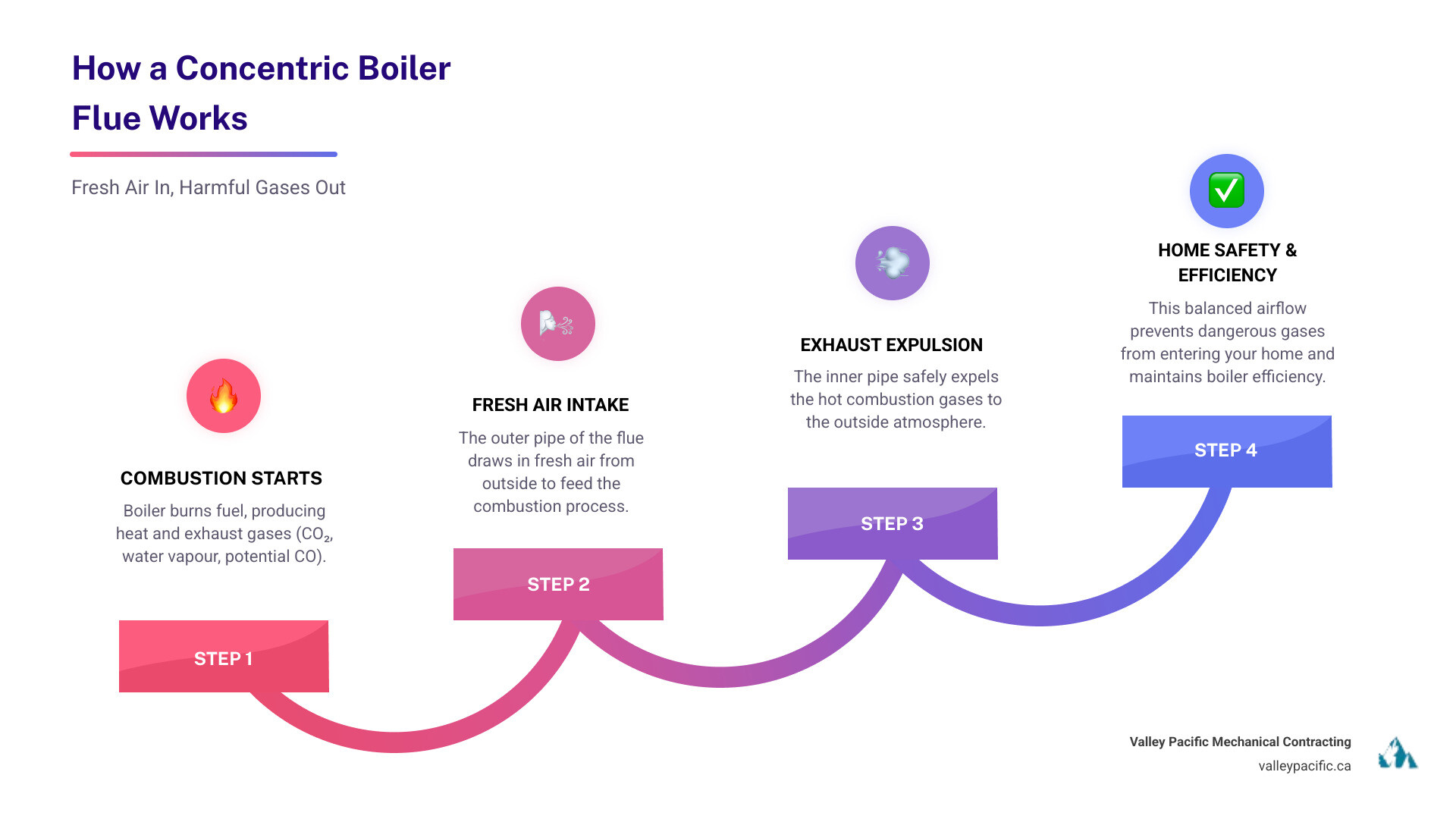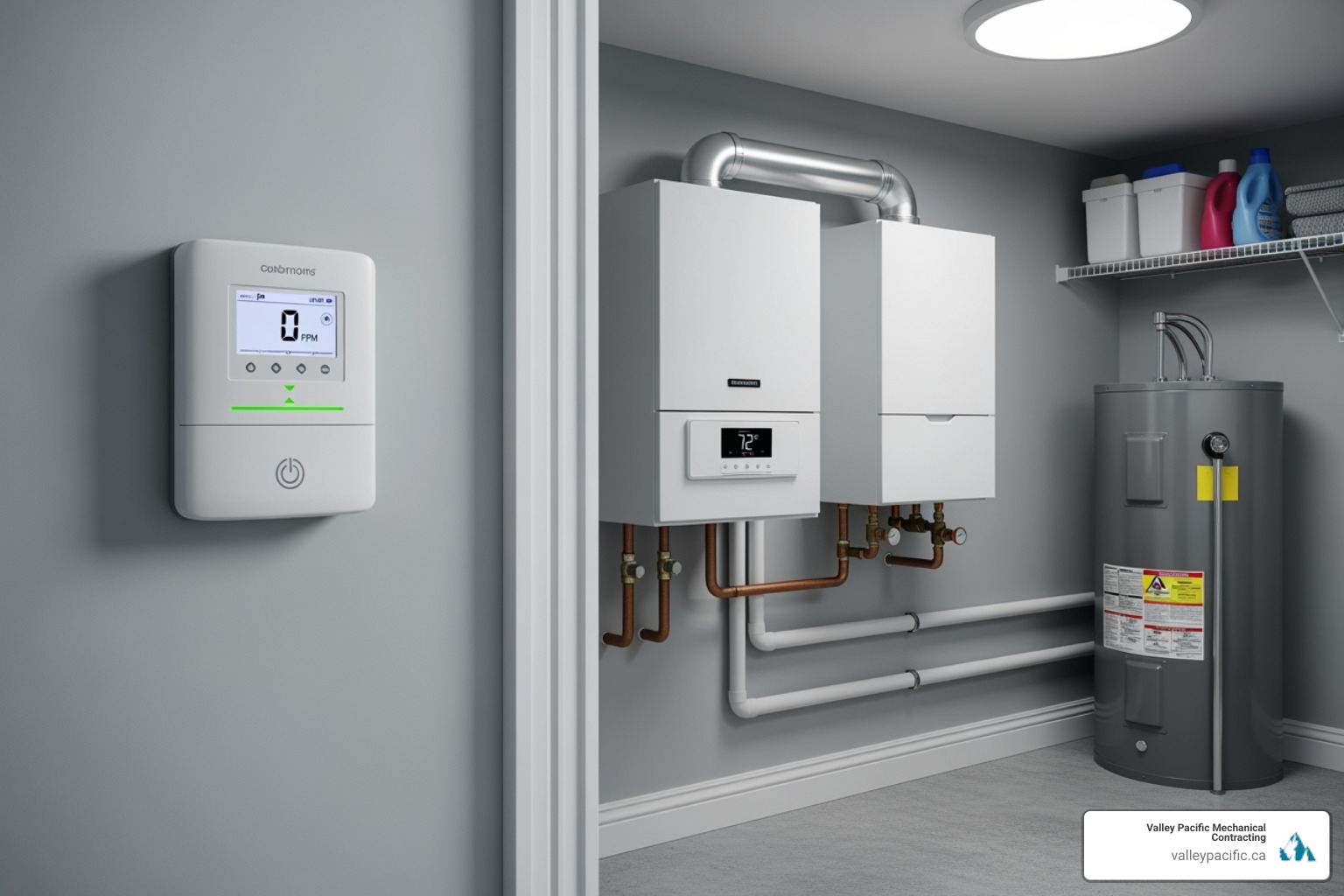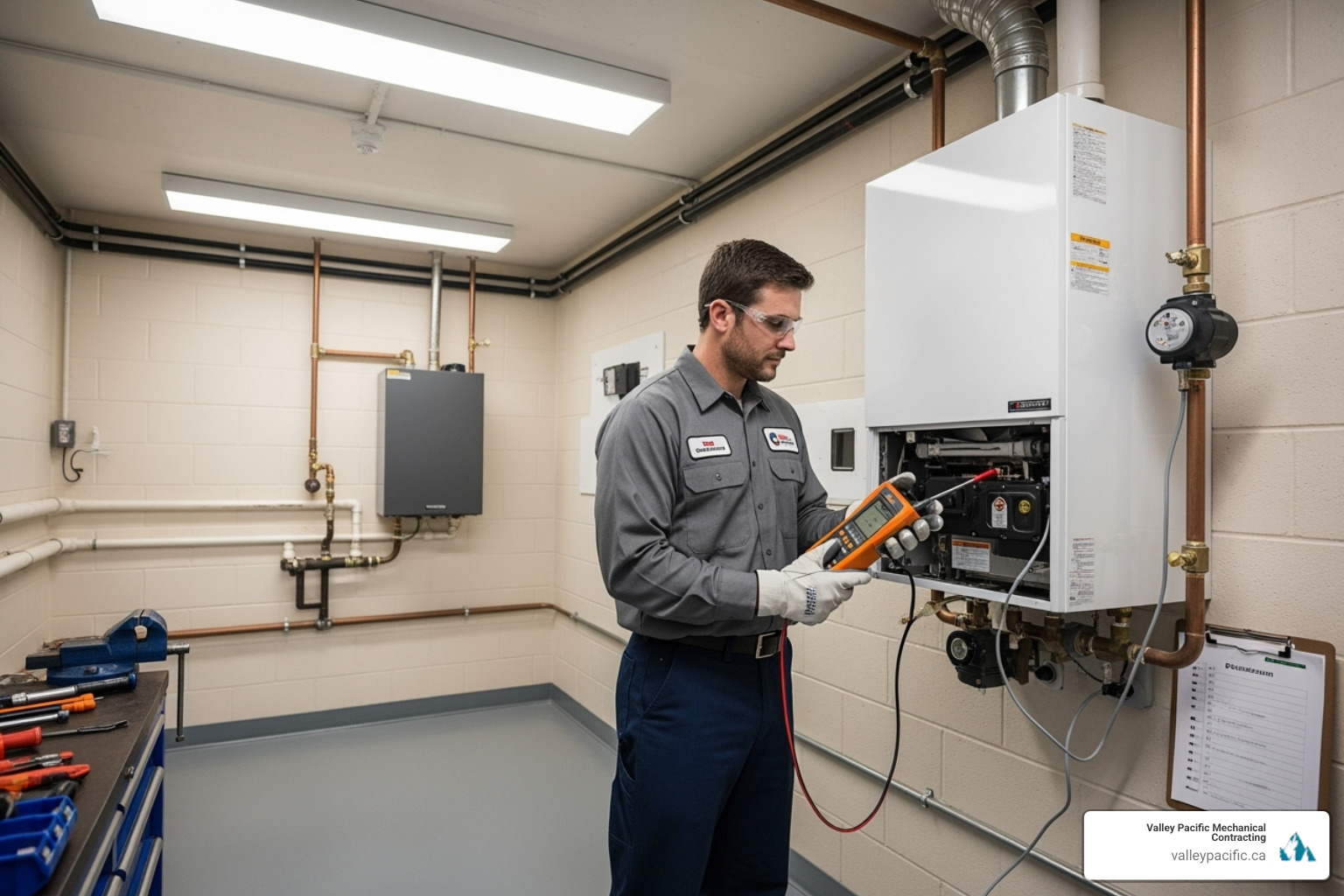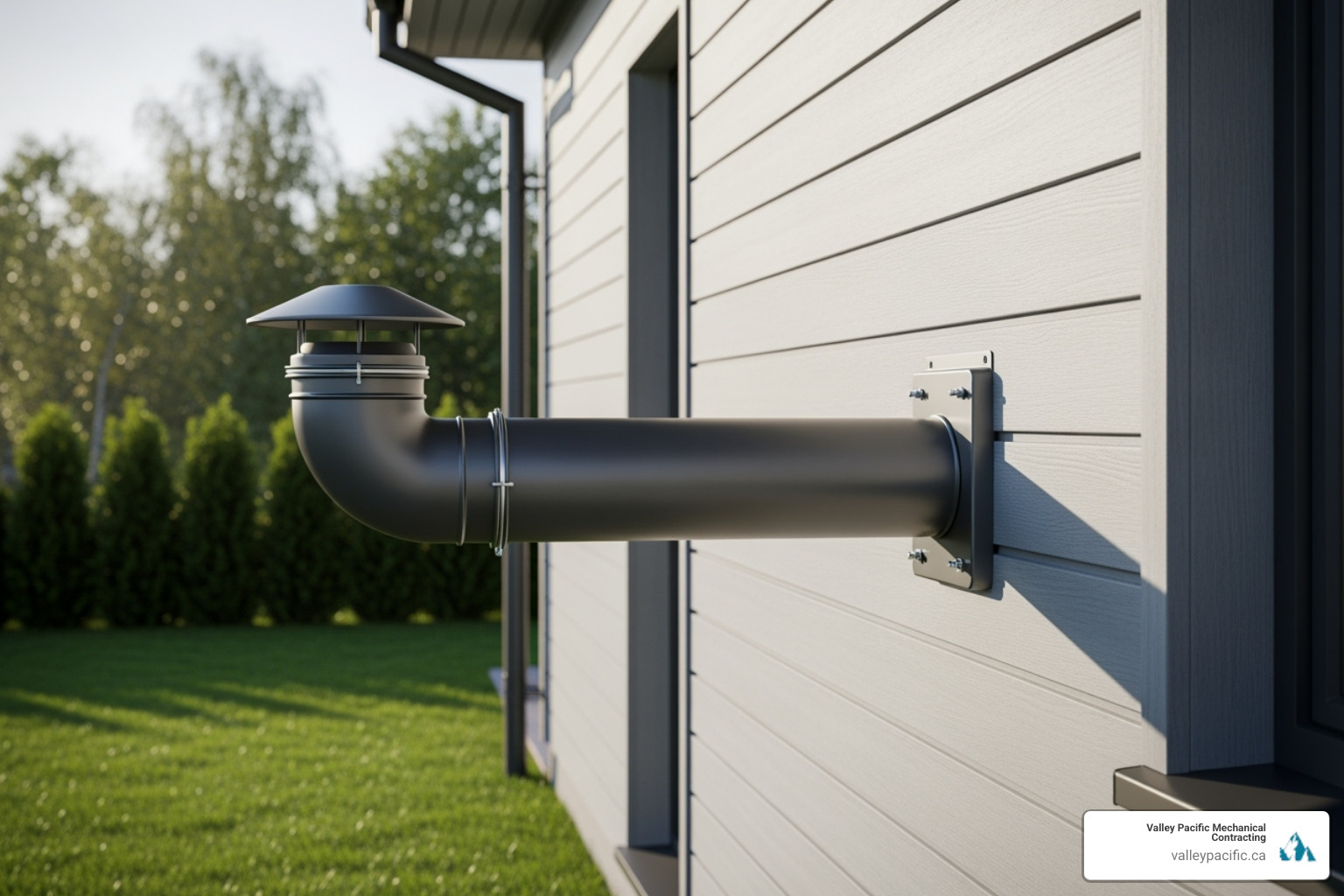DIY or Pro? Navigating Boiler Flue Repair

The Unsung Hero of Your Heating System
Boiler flue repair is essential for safely expelling dangerous combustion gases like carbon monoxide from your home. While some visual checks are safe for homeowners, actual repairs must be performed by licensed gas fitters to ensure safety and code compliance.
Key things to know:
- What it is: A pipe system that removes exhaust gases (CO₂, water vapour, carbon monoxide) from your boiler to the outside
- Warning signs: Soot marks, condensation, damaged pipes, blockages, pilot light issues, or unusual noises
- DIY limit: You can visually inspect and clear exterior debris only—all repairs require a professional
- Safety critical: A faulty flue can allow carbon monoxide to leak into your home
- Inspection frequency: Annual professional inspection as part of your boiler heating system maintenance
Most homeowners rarely think about their boiler flue until something goes wrong. Yet this seemingly simple pipe plays a life-saving role in your home's safety. Every time your boiler fires up, it burns fuel to create heat—a process that produces carbon dioxide, water vapour, and potentially deadly carbon monoxide.
The flue's job is to safely escort these combustion byproducts outside your home. When it works properly, you never notice it. When it doesn't, the consequences can be severe, from boiler breakdowns to serious health hazards.
Understanding when you can safely inspect your flue yourself—and when you absolutely need a professional—can save you money, protect your family, and keep your heating system running efficiently. This guide will help you steer that crucial distinction.

Key terms for Boiler flue repair:
Identifying Flue Problems: Telltale Signs of Trouble
Your boiler flue is designed to work silently in the background, faithfully venting combustion gases without fanfare. When everything's running smoothly, you'll never give it a second thought. But when problems develop, your heating system has ways of letting you know—sometimes subtly, sometimes not so subtly.
The key is knowing what to look for. Catching these warning signs early can prevent a minor inconvenience from becoming a serious safety hazard, especially when it comes to carbon monoxide exposure.
A healthy flue operates quietly and efficiently. When something goes wrong, you'll typically notice changes around your boiler or along the flue system itself. During your routine visual checks, keep your eyes open for these telltale signs.
Soot or black marks around the boiler casing or where the flue connects to your wall or ceiling are serious red flags. These dark stains mean combustion gases aren't being properly expelled—they're leaking into your home instead. This isn't something to ignore or put off until next week. It requires immediate professional attention.
Condensation or drips around the flue pipe deserve a closer look. Yes, modern condensing boilers naturally produce moisture, but that condensate should drain away through a separate pipe. If you're seeing excessive moisture, puddles, or dripping directly from the flue, you've likely got a leak. The acidic nature of this condensation can eat away at metal components over time, causing further damage. If you're dealing with unexpected water issues, our article on boiler leaking water can help you understand what might be happening.
Take a moment to inspect any accessible sections of the flue pipe for physical damage. Look for cracks, corrosion, dents, or sections that seem loose or disconnected. Even minor damage can compromise the entire system's integrity, creating pathways for dangerous gases to escape into your living space.
The external terminal where your flue exits your home is particularly vulnerable to blockages from debris. Leaves, twigs, and bird nests can accumulate there, especially after storms or during fall. We've even seen ambitious birds build entire nests inside terminals during spring! A blocked terminal prevents proper ventilation and can force combustion gases back into your home.
If your boiler has a pilot light, pay attention to its behavior. Does it frequently go out? Is the flame weak or yellow instead of strong and blue? These symptoms often point to ventilation problems related to the flue. A compromised flue restricts the oxygen supply needed for complete combustion, directly affecting your pilot light's performance. Our guide on boiler pilot light issues explores this connection in more detail.
Unusual noises coming from your boiler—banging, whistling, or gurgling sounds that weren't there before—can also indicate flue problems. A blocked flue creates pressure imbalances that affect your boiler's operation, sometimes producing these strange sounds.
Common Signs You Need Boiler Flue Repair
Beyond these general warning signs, certain specific indicators almost always mean your flue needs professional attention. Ignoring them won't just affect your heating efficiency or increase your energy bills—it could create a genuinely dangerous situation in your home.

White, powdery stains around flue connection points—often called oxidization—are telltale signs of leaking acidic condensate. When this corrosive moisture escapes and reacts with surrounding materials, it leaves these distinctive white marks behind.
Physical damage to the flue pipe itself demands immediate action. Cracks, holes, or significant corrosion compromise the flue's fundamental purpose: safely venting gases outside your home. These aren't cosmetic issues that can wait—they're structural failures that need addressing.
Loose fittings along the flue system might seem minor, but they matter more than you'd think. Missing screws, unsecured joints, or wobbly sections create potential leak points. Every component should be tightly fitted according to manufacturer specifications. While some homeowners debate whether every single screw is critical, we always recommend ensuring everything is properly secured—why take the risk?
Modern boilers are remarkably smart, and error codes are their way of communicating with you. If your boiler displays a fault code—especially one related to ventilation, combustion, or exhaust—don't ignore it. Check your manual, as these codes often point directly to flue issues that need professional diagnosis.
Finally, poor boiler performance can be your flue's way of crying for help. Is your home taking longer to heat up? Is your hot water not as hot as it used to be? A struggling flue leads to inefficient combustion, forcing your boiler to work overtime just to maintain comfortable temperatures. You might notice cold spots in your radiators or find yourself troubleshooting no hot water from boiler problems that seem to come out of nowhere.
When you spot any of these signs, it's time to call in the professionals for boiler flue repair. Your safety—and your family's—depends on it.
The Critical Dangers of a Faulty Flue
Let's talk about something that keeps us up at night: carbon monoxide. When your boiler flue isn't working properly, you're not just dealing with a broken heating system—you're facing a genuine threat to your family's safety.
Carbon monoxide (CO) is produced whenever your boiler burns fuel. It's a colourless and odourless gas, which means you can't see it, smell it, or taste it. There's absolutely no way to detect it with your senses alone. This invisible nature is precisely what makes it so dangerous.
When your boiler's flue is blocked, damaged, or improperly installed, the fuel doesn't burn completely. Instead of clean combustion, you get incomplete combustion that produces excess carbon monoxide. And when that CO can't escape through the flue as designed, it has nowhere to go but back into your living space.
The symptoms of CO poisoning often masquerade as common ailments—headaches, dizziness, nausea, weakness, fatigue, confusion, or chest pain. Many people mistake these warning signs for the flu or food poisoning. That's the terrifying part: you might not realize what's happening until it's too late.
A faulty flue creates a perfect storm for boiler malfunction. Without proper ventilation, your boiler can't draw in the fresh air it needs for clean, efficient combustion. The result? More carbon monoxide production, reduced efficiency, and dangerous gases accumulating in your home instead of being safely expelled outside.
This is why we're absolutely adamant about the importance of CO alarms in your home. Install them near your boiler and in sleeping areas. These devices are your first line of defense against this silent threat. And if you ever suspect a gas leak or carbon monoxide presence, follow emergency advice from authorities like the National Grid or your local gas provider. Don't take chances—evacuate and call for help immediately.
Why a Blocked Boiler Flue is a Silent Threat

A blocked flue doesn't announce itself with flashing lights or alarm bells. It quietly and methodically puts everyone in your home at risk. Understanding why makes the threat real and emphasizes why boiler flue repair is never something to postpone.
When your flue becomes blocked—whether from debris, a bird's nest, or damage—the combustion gases have nowhere to go. Instead of flowing safely outside, they experience what we call gas backdraft. The exhaust reverses course and flows back into your home, bringing carbon monoxide and other toxic byproducts with it.
At the same time, that blockage creates oxygen starvation inside your boiler's combustion chamber. Your boiler needs a constant supply of fresh air to burn fuel cleanly. Cut off that oxygen supply, and the entire combustion process suffers.
This oxygen deficit leads directly to incomplete combustion—the primary culprit behind carbon monoxide production. A boiler that can't breathe properly becomes a CO factory, turning what might have started as a minor blockage into a life-threatening situation.
The risk to occupants is what drives our urgency around these issues. Because carbon monoxide gives you no sensory warnings, a blocked flue can silently fill your home with deadly gas while you sleep, watch TV, or go about your daily routine. You simply won't know until symptoms appear—or until your CO detector sounds.
If your carbon monoxide alarm goes off, or if you notice any warning signs we've discussed, take immediate action. Turn off your heating system right away. Open every window and door to ventilate your home thoroughly. Get everyone out—family members and pets included. Then call emergency services and your gas provider from a safe location outside.
Never re-enter your home until emergency personnel have declared it safe. This isn't the time for second-guessing or "just checking" if things are okay. When it comes to carbon monoxide, caution isn't just wise—it's essential.
We're here around the clock for situations like these, providing expert Boiler Repair Coquitlam and emergency service throughout the Lower Mainland. Your safety is always our top priority.
DIY vs. Professional Boiler Flue Repair: What You Need to Know
Let's be honest—there's something deeply satisfying about fixing things around your home yourself. Maybe it's the sense of accomplishment, maybe it's saving a few dollars, or maybe you just enjoy the challenge. We get it. But when it comes to boiler flue repair, we need to have a frank conversation about where that DIY spirit needs to stop.
This isn't us being precious about our profession. It's about keeping you and your family safe. The combustion gases flowing through your flue include carbon monoxide—a substance that doesn't give second chances. That's why actual repairs to your boiler flue system must always, without exception, be performed by licensed professionals. Not "handy people who've done it before," not "my neighbour who used to work in construction"—we're talking about certified gas fitters who are legally authorized to do this work.
The Limits of DIY: What Homeowners Can (and Can't) Do
That said, you're not completely powerless. There are several important tasks you can—and should—handle yourself to help keep your heating system healthy and catch problems early.
Visual checks for blockages are perfectly safe when done from the ground. Every few weeks, especially after storms or during autumn when leaves are falling, take a moment to look at your flue terminal. You're checking for obvious obstructions—leaves, dirt, spider webs, or anything else that shouldn't be there.
If you can safely reach the terminal without climbing ladders or putting yourself at risk, clearing debris from the terminal exterior is fine. We're talking about gently removing visible debris from the outside opening only. Think of it like clearing leaves from a gutter downspout—simple, external maintenance.
Checking your CO alarm batteries might be the most important task on this list. Test your carbon monoxide detector regularly by pressing that little test button, and replace batteries the moment you hear that annoying low-battery chirp. This device is literally your family's early warning system.
You can also help by keeping the area around your flue clear. Make sure shrubs or trees aren't growing too close to the terminal outside, and keep the space around your boiler inside free from clutter. Your technician will thank you when they come for service.
Now, here's where you stop. The moment you notice damage to the flue pipe itself, suspect an internal problem, see soot marks or white staining, or if your CO alarm sounds—step back and call a professional. This isn't about questioning your abilities. It's about recognizing that gas work is governed by strict legal and safety boundaries for very good reasons.
In British Columbia, all gas work—including boiler flue repair—must be performed by someone licensed through Technical Safety BC. Attempting to repair a gas flue yourself isn't just dangerous; it's illegal. It can void your home insurance, invalidate your boiler warranty, and most importantly, put lives at risk through improper combustion or gas leaks.
The Professional Approach to Boiler Flue Repair
When you call us for boiler flue repair, you're getting more than just someone with tools and experience. You're getting a systematic, safety-first approach backed by certification and specialized equipment.

Our team consists of licensed gas fitters certified by Technical Safety BC. This isn't just a piece of paper on the wall—it represents rigorous training and ongoing education in the latest safety standards and techniques. These professionals have the knowledge and legal authorization to work on your gas appliances safely.
One of the key differences between professional and amateur work is the use of diagnostic tools. We don't just eyeball your flue and make our best guess. Our technicians use flue gas analysers that measure exactly what's coming out of your system. These sophisticated devices detect inefficient combustion, carbon monoxide presence, and other invisible problems that could compromise your safety. It's like having X-ray vision for your heating system.
Ensuring code compliance is another critical piece of the puzzle. Building codes exist for a reason—they're written in response to decades of real-world experience, sometimes learned the hard way. Our technicians know these regulations inside and out, from proper clearances to approved materials to correct securing methods. When we complete a job, you can be confident it meets every safety standard.
When we assess your flue, we're making an important decision: repair or replacement. Sometimes a targeted repair is the right call—perhaps resealing a joint or replacing a damaged section. Other times, especially with older flues that don't meet current codes or have extensive damage, replacement is the safer and more cost-effective long-term solution. We'll always explain our reasoning and help you understand your options. If you do need a new system, our Professional Boiler Replacement Process takes the stress out of the transition.
Finally, we can't emphasize enough the value of an annual boiler service. Think of it as a check-up for your heating system. During this service, we inspect your entire boiler and flue system, checking for wear and tear, blockages, leaks, and early warning signs of future problems. Catching issues before they become emergencies saves you money and keeps your family safe. If you're in our service area, check out our Boiler Repair Langley Guide for more information about what we offer locally.
Understanding Flue Types and Regulations
When it comes to boiler flue repair, one size definitely doesn't fit all. The flue system connected to your boiler isn't just a generic pipe—it's a carefully engineered component designed to work with your specific heating system. Understanding these differences can help you appreciate why professional expertise is so crucial when repairs are needed.
Your boiler and its flue are essentially a matched pair. You can't simply swap flue components between different boiler models or manufacturers and expect things to work safely. Each boiler's combustion system has unique requirements for how much air it needs to draw in and how efficiently it must expel exhaust gases. The flue is designed to meet those exact specifications.
One of the biggest distinctions in the boiler world is between condensing and non-condensing boilers. If you have a modern condensing boiler (and most homes do these days), it's designed to squeeze every bit of heat possible from the combustion process. This efficiency comes with a trade-off: the exhaust gases cool down so much that they produce acidic condensate—basically, acidic water that drips out during operation.
This means condensing boiler flues must be made from corrosion-resistant materials like plastic (PVC or polypropylene) or stainless steel. They also need a proper drainage system to handle that condensate. Older non-condensing boilers, on the other hand, run much hotter and don't produce this condensate, so their flues are typically made from different materials and have simpler designs.
Every boiler manufacturer provides detailed specifications for their flue systems, and these aren't just suggestions—they're requirements. Following manufacturer specifications ensures your boiler operates safely, efficiently, and within warranty terms. Our certified technicians always consult these guidelines when performing any boiler flue repair work.
Beyond manufacturer requirements, all flue installations and repairs must comply with local building codes. Here in British Columbia, these codes are quite specific about everything from flue materials and diameter to how long the flue can be, how many bends it can have, and how far it must be from windows, doors, property lines, and combustible materials. These regulations exist for one reason: your safety.
When you're preparing your home for a new boiler, understanding these requirements from the start makes the installation process much smoother.
Flue Configurations and Materials
The type of flue your home needs depends on several factors: your boiler model, where it's located, and the layout of your home. Let's look at the main configurations you'll encounter:
Horizontal flues are by far the most common, especially with modern condensing boilers. These run directly from your boiler through an exterior wall, expelling exhaust gases horizontally. They're straightforward to install when your boiler is positioned on an outside wall, and they're typically the most cost-effective option.
Vertical flues take a different route—straight up through your roof. You'll often see these in homes where the boiler is located in an interior room or where a horizontal flue isn't practical. Vertical flues require special weathering slates or flashing where they penetrate the roof to prevent water infiltration. Proper sealing is critical here, as roof penetrations are always potential weak points for leaks.
Concentric flues are clever pieces of engineering—they're essentially a pipe within a pipe. The inner pipe expels exhaust gases while the outer pipe draws in fresh air for combustion. This design is particularly useful for room-sealed boilers that don't draw air from inside your home. You'll recognize these by their distinctive double-ring appearance at the terminal.
Twin flues use two separate pipes running side by side—one for air intake and one for exhaust. While they serve the same function as concentric flues, they're used in situations where a concentric design won't fit or isn't suitable for the installation.
If you have an older home, you might still have a square metal flue rather than the round plastic or stainless steel flues common today. These older flues were standard with non-condensing boilers and are often made from aluminum or galvanized steel. While they can still be safe if properly maintained, they're not suitable for modern condensing boilers.
The material your flue is made from matters tremendously. Modern condensing boiler flues are typically white or gray plastic (PVC or polypropylene) because these materials resist the acidic condensate. High-efficiency systems might use stainless steel, especially for longer flue runs. Older systems used aluminum or galvanized steel, which work fine for high-temperature exhaust but would corrode quickly with acidic condensate.
Whether you need boiler installation in Maple Ridge BC or anywhere else in the Lower Mainland, our team ensures your flue configuration meets all manufacturer specifications and local codes. We've seen countless homes with different layouts and challenges, and we know how to design a safe, compliant flue system for any situation.









